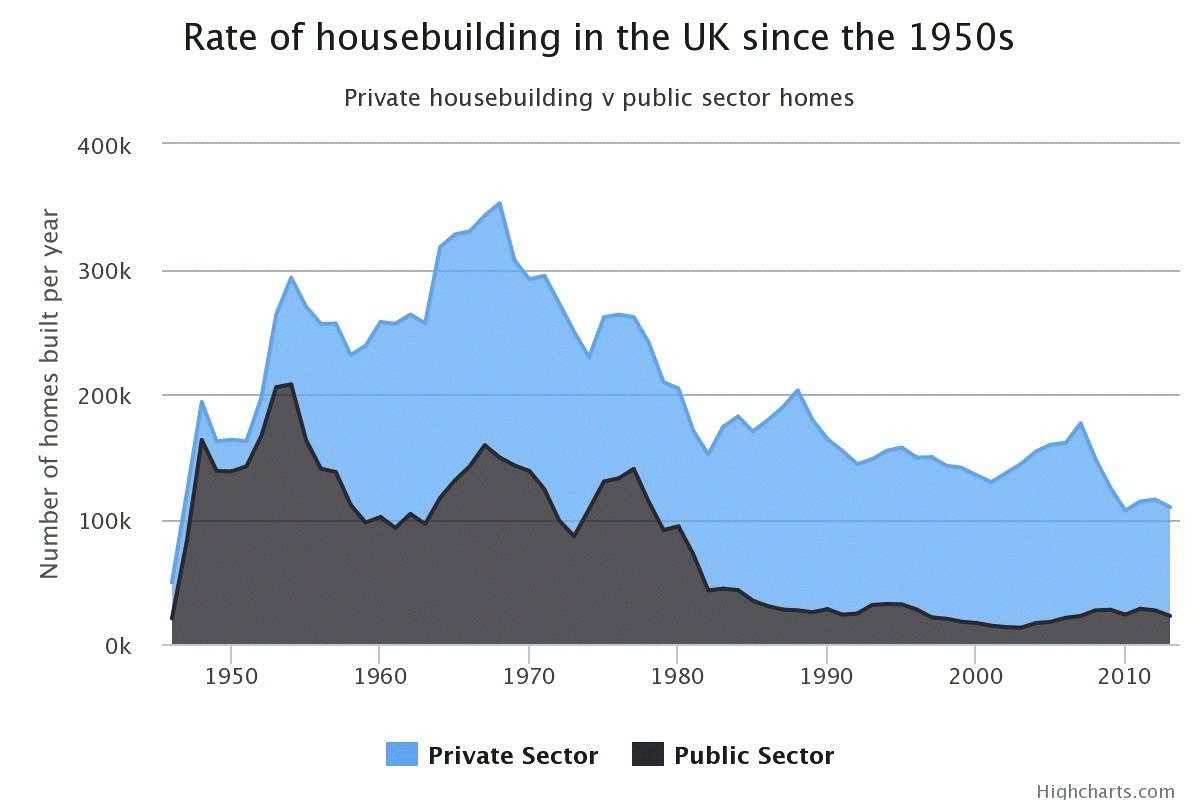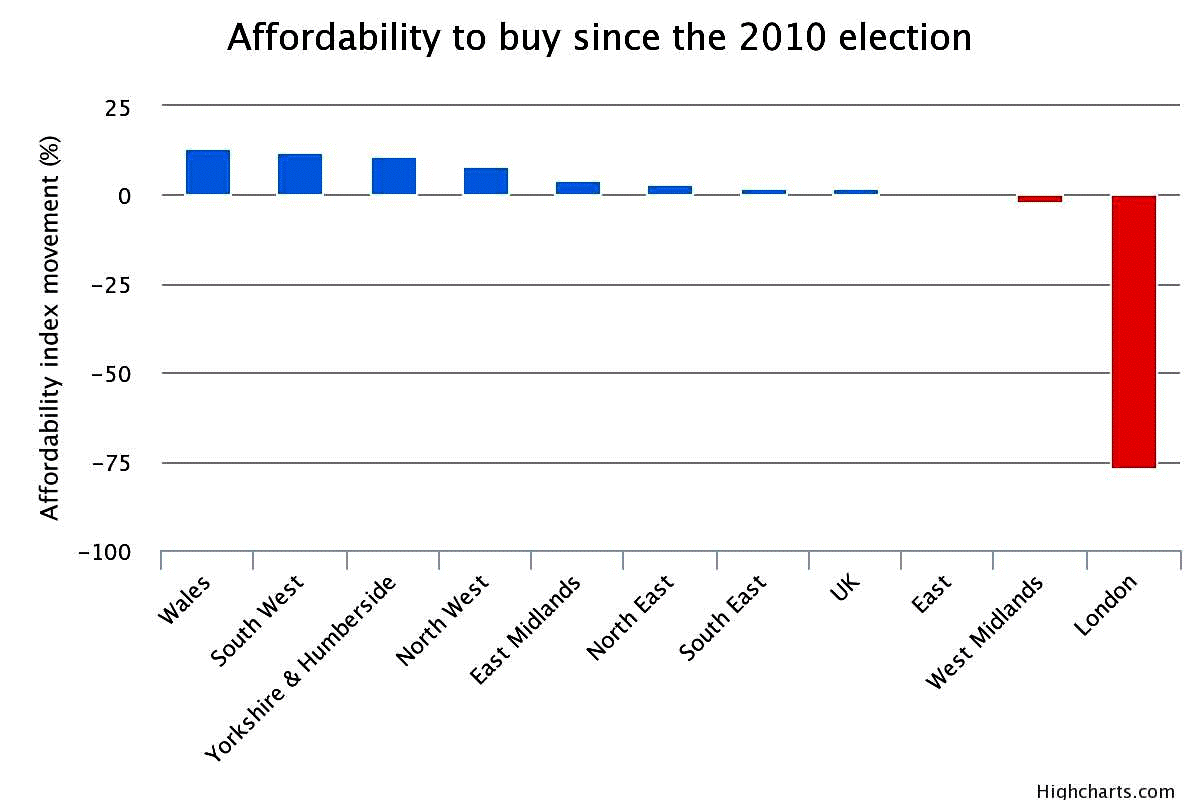Housing policy was one of the hot topics in the first election after the Second World War, when Clement Attlee beat Winston Churchill to Number 10, launching a tide of social reform. The Labour leader’s promise to rebuild bombed-out Britain with streets of council housing helped him win the vote over Britain’s wartime hero.
Seventy years later, housing is back at the top of the agenda. David Cameron’s promise to allow housing association tenants to buy their homes at a discount harks back to 1979, when the right to buy council houses was a key part of the manifesto that took Margaret Thatcher into Downing Street.
Since then, her dream of a property-owning democracy has declined as building homes dropped down the political agenda. Over 30 years of neglect, a chronic supply crisis has enveloped Britain, particularly in the South East, sending prices soaring beyond the incomes of most ordinary buyers.
Suddenly, property is again a hot political topic.

In December, the Chancellor, George Osborne, carefully positioned himself as the friend of home owners, introducing a stamp-duty overhaul that benefits 98 per cent of them. The extension to the shared equity and loan guarantee scheme, Help to Buy, and accompanying Isa, plugged at the Budget in March, along with a promise to discount homes for first-time buyers, also shows the Tories trying to appeal to a young generation of renters desperate to get on the ladder.
Labour, meanwhile, has its eye on the army of first-time buyers priced out of the market. It has promised to unleash a building boom, introduce a mansion tax and its manifesto mentions the phrase “housing crisis” three times. (Ukip uses it once, the only other party to do so.)
So what will actually happen to the property market after the votes are counted? For property obsessives, home owners and buy-to-let investors, our panel of six independent property experts analyses what’s on offer, and which party will mete out the best policies to create a healthy, sustainable housing market and cushion the market against both boom and bust.

Supply
In 2014, a total of 118,770 new homes were built, according to the Department for Communities and Local Government. It sounds a lot, but it’s less than half the annual, industry-accepted figure required to tackle the housing shortage.
By 2020, the Conservatives have promised to build 200,000 starter homes for first-time buyers, more garden cities and a further 400,000 new units from brownfield land.
Labour is also offering garden cities, and has pledged to build 200,000 homes a year.
The Liberal Democrats want 300,000 new homes a year, in at least 10 garden cities, while Ukip is proposing a £1 billion brownfield site revolution.
The Greens aim to build 500,000 social rented units, by quadrupling spending and allowing councils to borrow more money.
But who do our experts think will actually deliver the most new homes?
Becky Fatemi - managing director of London estate agent, Rokstone

The Conservatives have positioned themselves as “friends” of the property industry with plans already costed-out in detail. Labour has taken a polar opposite stance. Their plans for a mansion tax, abolishing non-dom status and allowing local authorities to compulsory-purchase unused sites from developers is likely to suppress new development and further cool the housing market in the capital and surrounding Home Counties.
Russell Quirk - chief executive of online estate agent eMoov

Since taking office in 2010 the Conservative/Liberal Democrat coalition has delivered a lower level of housing than any government since the Second World War (135,000 per annum). An appalling record of failure.
Labour’s record has been better, especially in the Fifties and Sixties, but the Blair/Brown years saw a decease in growth. The data shows that Labour are a better bet for house building yet none of the promises of politicians of recent years has matched the reality.
Danny Dorling - professor of human geography at Oxford University

The UK needs more homes for three main reasons. Firstly homes wear out. They don’t last forever. Secondly the number of households in the country is rising partly due to immigration. Thirdly we are aging and we need more homes suitable for people who are very old but located near to where the old currently live. Population numbers are hardly falling in any part of the UK, so building most new homes where there is the greatest demand for housing will not harm other parts of the UK because homes are not being demolished in large numbers anywhere.
If more homes are to be built a wider range of builders will be required to build them and not simply a few very large monopolistic giants working to maximise their profits. This will require government intervention to correct the failure of the market. Regardless of who wins, without that intervention we should not be surprised if the building is slow.
Angela Kerr - director at the HomeOwners Alliance

The Liberal Democrats’ promise of 100,000 more homes than other main political parties is seductive, but the Labour and the Conservative packages make for more convincing reading in getting more homes built.
However, believing any of these promises takes a leap of faith after decades of poor form.
As well as a clear, strong commitment to build new homes in big numbers, today’s housing crisis requires political parties to facilitate building by private developers, local authorities and agencies by unblocking the planning system and releasing public land and brownfield sites.
Henry Pryor - Independent buyer

If you believe in fairies and election manifestos then the Greens will build the most homes with a promise to build 500,000 social rented homes paid for from reforming tax breaks for landlords including scrapping Buy-to-let mortgage interest relief. They also ‘pledge’ to bring back 350k empty homes.
Labour will need a full five years to get their plans on track by which time it’s unlikely they will be building more than their competitors. The losers will still be those unable to get help to afford the high housing costs that no party has the political nerve to address.
Affordability
For the Government, the recent rise in house prices – dramatic in London and the South East, less so elsewhere – poses a dilemma. With low mortgage rates, current home owners feel richer and spend more money, boosting the economy. However, many buyers are being left behind, forced into often expensive and insecure renting or still living with parents.
The Tory manifesto is aimed at the aspirational home owner with an extension of Help to Buy and a first-time buyer discount.
Ed Miliband has paid lip service to helping the first-time buyer without offering much detail, but he will introduce a mansion tax on £2 million properties, damping prices at the top end. The Liberal Democrats have pledged to build 30,000 rent-to-buy homes.
Ukip plans to axe stamp duty on the first £250,000 for new homes bought on brownfield sites, but the Green Party has taken the opposite tack and would scrap Help to Buy, reducing buyers and therefore prices.
The question is, which of the parties will strike the right balance and tackle affordability without widening the gap between forever-renters and home owners?
AK The Conservative Party is at risk of stoking up demand and increasing house prices with the extension of Help to Buy. But, if they can build the new starter homes in areas of need, the Help to Buy scheme and Isa is a great overall package to help first-time buyers across the country.
HP The Conservative plans look the most likely to result in higher rents and freehold values. This is because their economic policies are most likely to settle City nerves and continue to provide confidence and stability which in turn should help maintain low interest rates.
DD The political party that could increase affordability the most in the short-term is Ukip (but I do not support Ukip). If Nigel Farage’s party were to become a coalition partner and insist on far more draconian limits to migration then we should expect many people from the mainland of Europe to leave. That would reduce housing demand (and therefore prices) substantially. However, as the economy spiralled downwards when the young and productive left, overall ability to pay for housing and rents may fall even faster than housing prices. A vote to leave the European Union (as promised by the Tories) could do the same thing.
BF All the parties have policies to help make homes more affordable, but different approaches. Tory plans are much more market-driven, while Labour will empower local authorities to build social housing stock as they did in the post-war period. The SNP said it opposes the Right to Buy initative.
RQ The Tories have been twice as “good” at ensuring house price rises, therefore home owners should vote blue.
A healthy housing market
Rocketing house prices are not a sign of a healthy market. Steady long-term growth is the obvious prescription, achieved by rising wages, inflation, credit availability and a plentiful injection of housing stock.
The Tories will sell off expensive social housing to pay for first-time buyer homes, but will they replace them? Labour would have us believe that taxing rich home owners will help bring down Britain’s debt but this could reduce the amount of money coming into London and hit the service industry.
So which party will nurse the housing market back to good health?
RQ This is an economic consideration. House prices do better as a consequence of low inflation, low interest rates and strong economies. The Conservatives win here. Labour will reel from its economic record for some time and many will believe that a vote for Labour is a decidedly more dangerous proposition. A Conservative majority is the best outcome for the housing market.
BF There are many different housing markets. If the Tories win there will be a huge wave of new developments and second-hand properties placed on the market. There will also be a rise in sales in the £2 million-plus market and investors and banks will return to putting money into luxury housing projects. All of this will trigger a further rise in house prices. Under a Labour-led government there will be a boom in new homes below £1 million and bankers and private investors will focus on backing projects that provide starter and middle market housing.
HP I suspect that a coalition government will provide the most stable market, since the housing market fears uncertainty. There remain icebergs out there, the most frightening potentially being civil unrest. We saw in the 2011 riots what can happen when a significant number of people feel sufficiently disfranchised. But judging by the manifestos we’ve seen, it looks unlikely that one single party has an answer to the housing crisis, in the main because there is a significant, largely silent body of the electorate who isn’t convinced that if there is a crisis they want to be a part of the solution.
DD Whatever happens it is likely to take many decades before the UK has a healthy housing market. A healthy housing market is one in which people are able to house themselves and their families securely and not live in fear of eviction or being priced out of the market, or fear that the value of their homes may suddenly drop greatly. It is not produced when a few firms dominate home building and have such great political power.
The politicians most likely to create a healthy housing market are those who do not view the current market as healthy – likely to be younger MPs. The old guard were often able to use their allowances and second jobs to buy multiple properties in London.
All That is Solid: How the Great Housing Disaster Defines our Times, and What we Can Do About It, by Danny Dorling, is published in paperback by Penguin Books, priced: £9.99.



